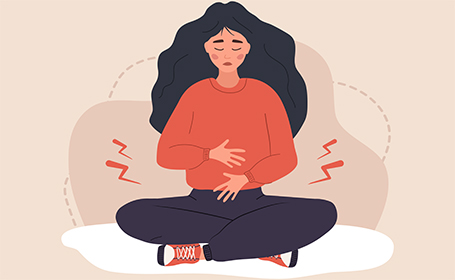
Dysmenorrhea - its not just heavy periods
Dysmenorrhea is the medical term for the severe pain experienced by many people during menstruation. According to the NHS, the pain can come in intense spasms or present itself as a constant dull ache.
What causes dysmenorrhea?
There are two kinds of dysmenorrhea, primary and secondary.
Primary dysmenorrhea
The pain that occurs before or during a period – often referred to as cramps – is primary dysmenorrhea. Chemicals called prostaglandins cause the uterus to contract, making the abdomen hurt. There are higher levels of prostaglandins during the earlier stages of a period, and this is why pain usually decreases after a couple of days. The pain can also be accompanied by back and thigh pain, nausea and diarrhoea.
Secondary dysmenorrhea
Period pain can also be caused by a physical disorder of the female reproductive organs, and this is known as secondary dysmenorrhea. This pain usually lasts longer than the pain from primary dysmenorrhea, and can get progressively worse over time.
Some of the causes of secondary dysmenorrhea are:
- Adenomyosis - when tissues grow in the muscle wall of the uterus that usually lines the uterus
- Fibroids - small growths that form in or around the uterus
- Endometriosis – when tissue similar to the lining of the uterus starts to grow in other areas of the body. Hormones cause the tissue to break down and bleed, which can cause extreme pain
Other issues and conditions related to the reproductive organs.
Some discomfort during a period is normal, but many women don’t go to their doctor when experiencing severe pain, even if it is disrupting their life.
How is dysmenorrhea diagnosed?
Doctors can investigate the causes of dysmenorrhea in a variety of ways. They may use a combination of the following methods:
- Pelvic examination;
- Abdominal examination ;
- Hysteroscopy, where a small telescope is passed through your vagina and used to examine your womb;
- Ultrasound scan, which uses high frequency wave sounds to create images of the inside of your body and
- Laparoscopy, where a small telescope is inserted into the abdomen under a general anaesthetic. This allows the doctor to see inside your body, and also take a sample of tissue (a biopsy).
Some discomfort during a period is normal, but many women don’t go to their doctor when experiencing severe pain, even if it is disrupting their life. For this reason, it can take a long time for women to have their symptoms investigated and reach a diagnosis. It can be especially difficult for women from marginalised communities to access accurate information and healthcare services surrounding these issues.
How dysmenorrhea impacts daily life
Dysmenorrhea can cause extreme pain, which may not be reduced by over-the-counter painkillers. It can have an incredibly disruptive effect on daily life. According to YouGov, 52% of women have experienced menstrual pain that has affected their ability to work, but only 27% told their boss about the cause. In addition, research shows 13% to 51% women have been absent from school or work at least once, and 5% to 14% are often absent owing to the severity of symptoms.
Dysmenorrhea and stigma
Research into women's health conditions is often underfunded. According to ground breaking research charity Wellbeing of Women, only 2.1% of all UK public and charity funded health research goes towards women's reproductive health and childbirth - despite women making up over half (51%) of the population. This means that women's health conditions, like dysmenorrhea, are often misunderstood. This can lead to inadequate policies and provisions in public health and workplaces, along with stigma.
Stigma means that women are less likely to seek treatment for debilitating conditions like dysmenorrhea. The Royal College of Obstetricians and Gynaecologists (RCOG) reported that 24% of women feel unable to seek care for health issues because they are embarrassed by their condition, and 24% were also afraid to ask for help because they were embarrassed about their body. 15% of the women asked felt unable to seek care due to feeling judged.
The RCOG has called for appropriate policies to cater for women's health conditions in the workplace. This could include measures such as flexible working, support from HR departments and adjustments to make the physical office environment more comfortable. Wider recognition of conditions like dysmenorrhea will enable women to be happier and healthier at work and in their personal lives.
Depending on the cause, there are several ways to treat dysmenorrhea... Surgery, medication, nerve stimulation or other treatments may be recommended to manage your symptoms.
Treatment for dysmenorrhea
Depending on the cause, there are several ways to treat dysmenorrhea. Your consultant will test and diagnose the reason for the pain and advise on the best treatment for you. Surgery, medication, nerve stimulation or other treatments may be recommended to manage your symptoms.
If you are struggling with symptoms of a gynaecological condition and would like to speak with one of our specialists, then you can book an appointment online or call us for fast access to treatment.
Tags
How do I book an appointment?
If you're concerned about symptoms you're experiencing or require further information on this subject, talk to a GP or see an expert consultant at your local Circle Hospital.